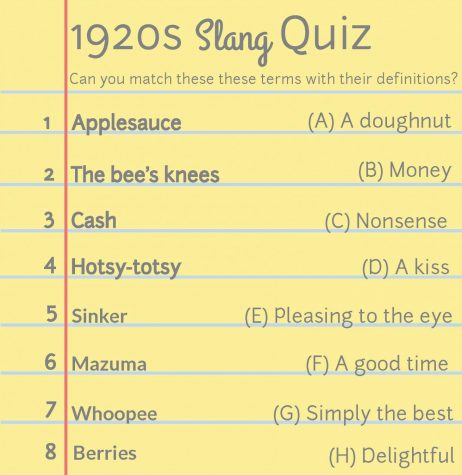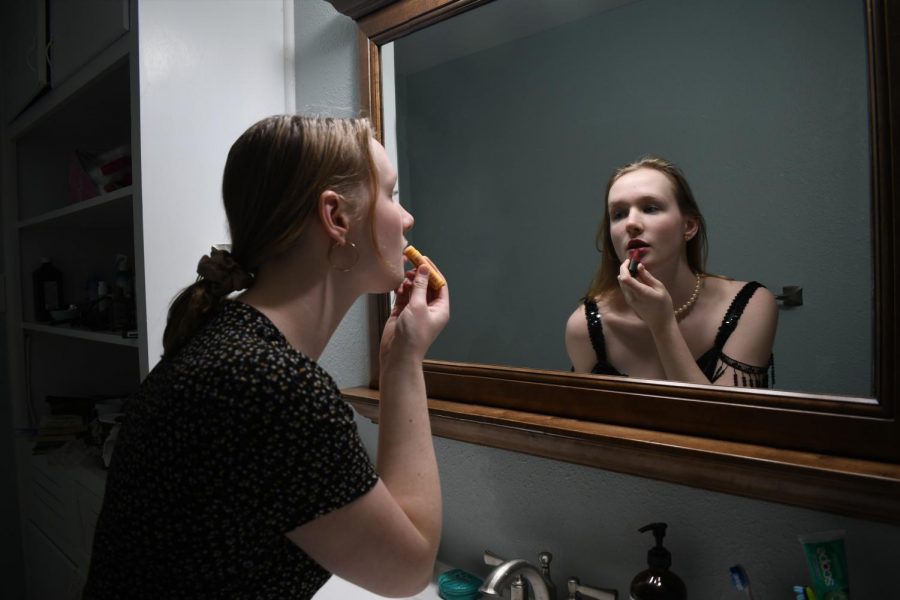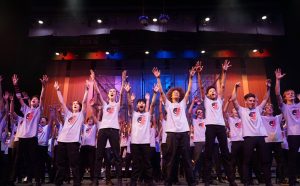Resuming the Roaring ’20s
Just hours from the 2020s, we look back to the 1920s to see how we’ve changed, stayed the same
THROUGH THE LOOKING GLASS: Junior Ellen Fox looks upon on a Roaring 1920s reflection of herself in the mirror. The reflection flaunts the staples of the time period: a flapper dress, a pearl necklace, and red lipstick. In the modern 2020’s version, she wears modern equivalents; a Madewell dress, hoops, a scrunchie and Chapstick. Original photos and digital illustration by Ellen Fox.
December 31, 2019
Betty admired herself in the mirror, smoothing down the curls of her bob and adjusting the position of her ribbon headband ever so slightly. She glanced at the clock — 11:58 p.m.? Grabbing her fur coat, she rushed back to her living room, the rich jazz spilling from the record player as her friends danced. Balloons, bright reds and yellows, floating at the ceiling, champagne bottles at each table, waiting to be popped. 3… 2… 1… Happy New Year — it’s 1920!
As we look forward into this new year, it is striking to reflect upon the ways our country has shifted over the past century, all the way from 1920 to the upcoming 2020. From hairstyles to music to the political and economic makeup of the country, it seems that one of the only things these two time periods have in common are the last two digits of their years.

Fashion grew to be one of the key reforms of the era, and, despite popular belief, the newest Nike sneakers and cropped tees were not sported in the 1920s. Girls tended to dress in long, brightly colored dresses paired with large hats or headbands, and, as fashion tends to follow the political and social trends of its time period, boys often wore bomber jackets to emulate their fathers who had fought in World War I. Junior fashion designer and previous winner of the McCallum Fashion Show Veronica Crist agrees that fashion follows this pattern of societal imitation.
“With fashion now, it’s all about how you can express who you are. It’s no longer about fitting in with the crowd,” she stated. “With people being more open to expressing their sexuality, beliefs, stuff like that, how you dress has become more of an individually based thing.”
Crist also described modern-day teen fashion as “more loose, more street-like, more comfortable,” addressing another major transformation the U.S. has made over this past century with direct roots in this early time period: beauty standards, particularly for women.
With the introduction of flappers, young women began doing the things least expected of them by society—smoking and drinking alcohol in public, applying heavier makeup and wearing outfits deemed as outrageously provocative at the time. This was a major shift. I mean… women? Actually making a lasting appearance in the public eye for something other than a familial task? Simply scandalous.
As this flapper fashion and lifestyle evolved, the rights of women began to change right alongside it. On Aug. 18, 1920, the 19th Amendment was ratified, granting women suffrage. According to BBC, the number of working women during this time period also increased by 25 percent, and they began to drop old habits of wearing constrictive clothing that was inconvenient for activity.
According to The Houston Chronicle, as of July 2018 men still dominate the workforce, but by a slimmer margin, with approximately 66 percent workers being male and 54.6 percent female (numbers do not add up to 100 percent because of reporting differences), a major shift in roles.
And let’s not gloss over the wild vocabulary used during this changing time—the slang terms, to use language we are familiar with. Just as there are now in America, plenty of colloquialisms and trending words were used in common 1920s culture. To describe something in a positive light, you could call something “the bee’s knees,” or simple just “berries.” However, if what you are describing is a person you find attractive, perhaps calling them “hotsy-totsy” would prove more effective. If your luck is good with this person, you might even end up giving them a “cash,” or kiss, hoping to have a “whoopee,” another word for a good time. Plenty of these phrases are still referenced in our society today, although not as prominently, while others faded along with the time period. Exclaiming “applesauce!” or referring to alcohol as “giggle water” are just two examples of this.
Just like in our current decade, there were societal shifts, both political and economic. According to financial website The Balance, economic activity increased by 42 percent in the decade alone due to the temptations of new consumer goods such as radios, vacuums and beauty products. With the approaching decline of the economy in the ’30s, however, the mass production of these products outweighed consumerism, and the economy came to a decline, just as it has in recent years.
Mirroring the changing economy, life was shifting for people of the ‘20s who would have been our age. This was also the period in which high schools started to take shape, redefining the lives of students. U.S. historians today also suggest that this was the first time the “teenager” age group began to develop—forming a new and distinct division between the younger and older youth groups. Popular teen culture, similar to the way it has developed now, had a heavy emphasis on music. While rap, hip hop, and alternative music have come to surface in this decade, the 1920s had its roots deep in the world of jazz. The U.S. was not only an adapter and influencer of jazz music, but the birthplace of it—the 1920’s in America was even deemed as “The Jazz Age.” It was a time for dancing and for celebration, a time to pick up your feet and groove to a tune.
Looking back upon this decade and the strides that have been taken since illustrate a strong pattern of advancement and change, from the clothes people wore to the way people described those clothes, from melodies and music to the woman’s role in society, and everything in between. It is the classic story of evolution and imitation.
As for the 2020’s, here’s to wishing you a decade that is truly the bee’s knees.
ANSWERS TO 1920s SLANG QUIZ: 1-C 2-G 3-D 4-E 5-A 6-B 7-F 8-H.








Zoe Burns • Jan 13, 2020 at 3:50 pm
This issue is one of my favorites. The stories and design drew me in and made me miss it the moment I turned the last page. I especially love the 20’s so this page remains one of the best in my mind. Well done!
Lily WIlson • Jan 10, 2020 at 9:15 pm
This story was relevant and fun, as 2020 has just approached. Discussing on aspects the 1920’s and comparing them to modern day norms was a good way to get the reader to reflect on life and how much things have changed in 100 years. I also really liked the quiz and the cover photo, both were nice additions that fit the theme of the story!
Camille Wilson • Jan 10, 2020 at 7:45 pm
I loved this story! The comparison of the new 2020 and the old, but then new, 1920. It was cool to see the similarities yet slight differences between the trends of now and then. This story was really nicely written and captivating. I think the beautiful picture and cute quiz added a lot to the piece.
Ella W • Jan 10, 2020 at 10:58 am
This story was a great way to inform people about the past and how it is so different from today. I liked how it covered topics not only concerning fashion., and how the article mentioned the beginning of the women’s suffrage.
Olivia Allen • Jan 10, 2020 at 9:36 am
This was a really good story. It was nice to see the history and how much things have changed in the past 100 years.
Zada Cook • Jan 9, 2020 at 10:09 am
This story was great! I really enjoy history and this story was a really fun way to learn more about the past. I liked how you touched on women and their lives at the time as well!
Angus Sewell McCann • Jan 8, 2020 at 9:11 pm
I love the way you started the story with the brief anecdote before moving into the meat of the story about 20’s fashion and pop culture and all. It caught my attention and kept it there throughout the rest of the story.
esme moreno • Jan 8, 2020 at 2:51 pm
I really like this story because it’s very informational in a way that’s not too hard to digest and I like how they compared the fashion of today’s teenagers to those of the 20’s.